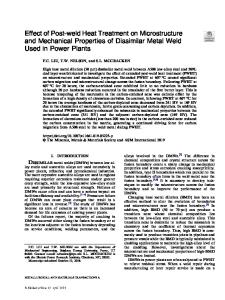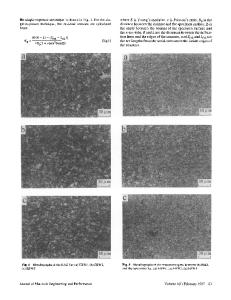Improving the properties of AA7075 resistance spot-welded joints by chemical oxide removal and post weld heat treating
- PDF / 4,314,412 Bytes
- 10 Pages / 595.276 x 790.866 pts Page_size
- 6 Downloads / 373 Views
RESEARCH PAPER
Improving the properties of AA7075 resistance spot-welded joints by chemical oxide removal and post weld heat treating Marcell Gáspár 1
&
Ádám Dobosy 1 & Miklós Tisza 1 & Imre Török 1 & Yangchun Dong 2 & Kailun Zheng 3
Received: 14 January 2020 / Accepted: 5 September 2020 # The Author(s) 2020
Abstract The aluminium alloy studied in this paper is the heat treatable AA7075 which has zinc as the main alloying element. 7xxx aluminium alloys have the best strength performance among all commercial series and AA7075 has tensile strength above 500 MPa. The outstanding strength properties open the possibility to use this alloy in automotive industry as a possible alternative material for car body elements instead of steel. However, their limited formability properties mean obstacle when a complicated shape car body panel is formed, since the elongation is limited only between 5 and 11%. In order to successfully form these sheets into the demanded geometry, hot forming should be used, and thus the body panels should be formed when the AA7075 is in a solution heat treated condition, such as using the HFQ® process. Then, after assembling the body elements, when resistance spot welding is among the most common joining methods, the AA7075 body parts should get the artificial ageing. It means that welding is followed by artificial ageing as a kind of post weld heat treating which can partially compensate the softening of this alloy during welding. Softening is considered among the most challenging weldability issues similarly to the high melting point oxide layer at the surface which also reduces the load bearing capacity of RSW joints. During the performed experimental program, three routes were investigated. The RSW experiments are performed on 1-mm-thick AA7075 sheets. The spot-welded joints were examined by macroscopic testing, tensile shear and hardness tests. Keywords Aluminium alloy . AA7075 . Resistance spot welding . HFQ . Oxide removal
1 Introduction Due to their relatively low density and good resistance to corrosion, aluminium alloys are among the best engineering materials used in automotive industry [1–3]. The most commonly applied types are the 5xxx, 6xxx and 7xxx groups, for example: 5754, 6082 and 7075 respectively [4]. 7xxx
aluminium alloys have the best strength performance among all commercial series and AA7075 has tensile strength above 500 MPa. The outstanding strength properties open the possibility to use this alloy in automotive industry as an alternative material for car body elements instead of steels. The AA7075 aluminium alloys are used in various car body elements because of its high specific strength, low quench sensitivity,
Recommended for publication by Commission III - Resistance Welding, Solid State Welding and Allied Joining Process * Marcell Gáspár [email protected] Ádám Dobosy [email protected] Miklós Tisza [email protected]
Kailun Zheng [email protected]
1
Institute of Materials Science and Technology, University of Miskolc, Miskolc-Egyetem
Data Loading...











